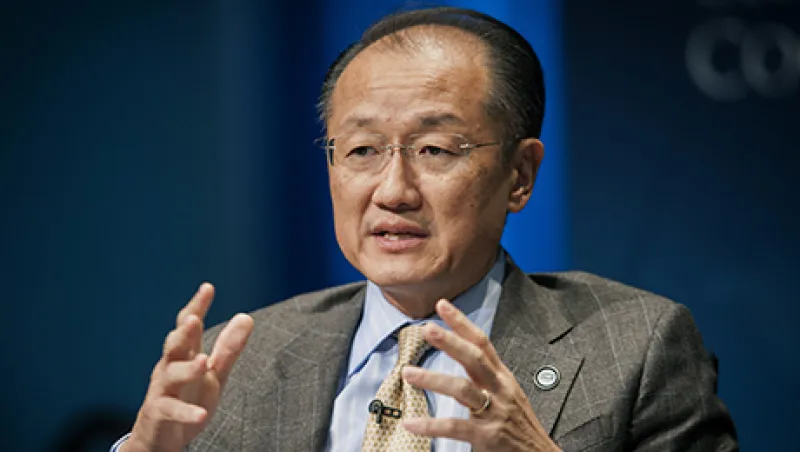Jim Yong Kim was a surprise choice to lead the World Bank when President Barack Obama selected him two years ago. A doctor and anthropologist, Kim brought plenty of passion for development and hands-on experience running community health care programs in countries from Haiti to Rwanda, but there was little in his background to suggest he was the best person to manage a sprawling institution like the bank. Two decades earlier, in fact, Kim was active in the “50 Years Is Enough” movement that campaigned to shut the bank and its Washington neighbor, the International Monetary Fund, contending they did more harm than good.
Today the world — and the World Bank — can finally take the measure of Kim. After more than a year of listening and learning and calling in consultants, Kim in recent months has undertaken the biggest restructuring of the bank in a generation. Beginning July 1 the development lender will abandon its old operating structure, which focused on individual countries, and adopt a new model of global practices based around 14 subject areas such as agriculture, finance, health and water.
By encouraging staff to share ideas and experience around the world rather than keeping them bottled up in national silos, the reorganization seeks to reposition the bank as a development institution whose knowledge is at least as important as its money. Kim believes the reorganization will enable the bank to fulfill the simple yet ambitious goal he has set for the institution: ending extreme poverty by 2030 and combatting inequality through shared prosperity.
“We will not just say, ‘You should do this,’” Kim says of the bank’s relationship with developing countries. “We will say, ‘Here is how countries and companies and organizations around the world have solved this problem in the most innovative and effective way.’ ... We’ve changed the focus from giving people papers and data and telling them what to do, to finding solutions.”
The demand for development solutions remains great around the world. Notwithstanding huge strides in development over the past 25 years, particularly in China, some 1.2 billion people — 20 percent of the population in the developing world — live on less than $1.25 a day. The recent economic slowdown — the bank last month cut its forecast for global growth this year, to just 2.8 percent from 3.2 percent previously — will make it harder to lift those people out of poverty.
The bank was certainly due for a shake-up. Former president James Wolfensohn carried out the last big reorganization in the mid-1990s, whittling at the institution’s bureaucracy and dispatching many Washington-based executives into the field. But the bank has languished in recent years under the presidencies of Paul Wolfowitz, the former U.S. Defense official, who resigned over an ethics scandal; and Robert Zoelleck, the former U.S. Trade Representative, who brought management rigor but eschewed the limelight.
Kim’s restructuring has affected some 6,000 of the bank’s 16,000 staff and replaced or reassigned a majority of its senior executives. The changes have raised hackles among staff, who have complained about a lack of consultation, but Kim, who met recently with a handful of reporters to discuss the changes, is determined to push through his reforms. “I’m willing to take the noise in the system; I’m willing to take the personal criticisms because the end is worth it,” he says.
The bank faces equally big challenges outside of the organization. Once the unquestioned leader on global development issues, the bank in recent years has taken a backseat to the IMF, which has orchestrated the response to the global financial crisis and Europe’s debt crisis. The World Bank also faces new rivals in the developing world. The leaders of Brazil, Russia, India, China and South Africa are expected to endorse a long-debated BRICS development bank when they meet in Brazil later this month. China is pushing to launch an Asian Infrastructure Investment Bank later this year. Both aim to address regional needs without resorting to the World Bank and the perceived dominance of the U.S., which appointed Kim and holds veto power over the institution.
Kim, who is seeking to launch a Global Infrastructure Facility at the World Bank to facilitate the financing of complex road, rail, power and other projects, says he welcomes the competition. Africa alone needs $100 billion in annual infrastructure investment, and the BRICS’s needs are estimated at as much as $1 trillion a year. “There’s all these trillions of dollars sitting on the sidelines earning very little interest,” he says. “And then there’s all these infrastructure needs, which we know are safer than most of those fund managers think they are, and are potentially extremely high-return investments that will in turn will have an impact on development on the ground.”
The president draws comfort from the robust demand for World Bank lending and advice. The institution expanded its loans, grants, equity investments and guarantees by more than 14 percent in the financial year ended June 30, to more than $60 billion, bank officials say. Kim believes the bank can continue to grow its lending, but he’s just as determined to restore the bank to a front-line position as a thought leader on global policy issues. He touts a bank report released last month, which claimed that efforts to combat climate change can actually boost world output, rather than dampen growth.
Kim has put his personal stamp on the bank and given it a challenging mission. The next year will tell whether his restructuring and management are up to the task. As one executive director puts it, “This is going to be the big test for Jim Kim and his leadership.”
Follow international editor Tom Buerkle on Twitter at @tombuerkle.






